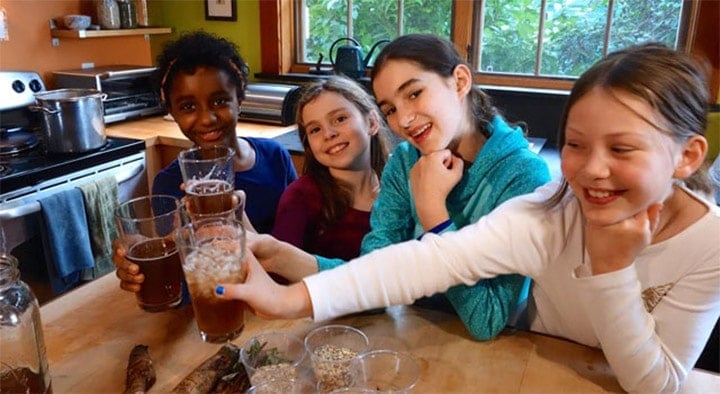In the fall, the plants return their vital energy to their roots as they prepare for the cold, dormant winter. So this is the optimal time to dig and harvest the roots — burdock, dandelion, comfrey… sassafras, sarsaparilla… What more delicious way to bring the nourishing, healing properties of the roots into our diet than making our own homemade root beer? It’s easy with this traditional root beer recipe.
Want to know how to make homemade root beer?
When we simmer the roots to bring their flavors into our soda syrup we’re also extracting the vitamins and minerals and other healing components into the water.
In this recipe, I’ve combined sassafras and sarsaparilla with burdock, licorice and astragulus to make a great herbal root beer recipe, a nourishing healing fall tonic. After I craft a healthy syrup with these roots, I then ferment the brew for several days, adding all those great microorganisms to our herbal root beer ferment that enhance our digestion.
As you can see, this fantastic root beer recipe that uses actual roots is much more than a delicious family treat; it is truly a fall health tonic with no artificial flavors or high fructose corn syrup.
Root Beer Recipe
This recipe is adapted from a root beer recipe in Stephen Cresswell’s Homemade Root Beer Soda and Pop and my experience in a soda making class taught by Jennifer Sundstrom and an article called Artisanal Home Soda Fermentation by Charles Eisenstein that can be found on the Weston Price Foundation website.
The process takes a couple of weeks; so don’t get started just before leaving on vacation.
Here’s how to make real root beer…
STEP 1: Creating Culture
The first step in learning how to make this delicious drink recipe is to create your soda culture. To do so you will need:
- 2 to 3 inch piece of fresh ginger root
- about a half a cup of sugar (white sugar is fine or you can use sucanat or maple syrup…)
- and a quart mason jar 3/4 full with water
Fill the mason jar to 3/4 full with filtered water (it’s best if you can remove the chlorine).
Add 1 tablespoon of ginger and 2 teaspoons of sugar. Stir well.
Cover with cheesecloth and allow to sit out for 24 hours.
Each morning for a week you will add another 2 teaspoons of sugar and 2 teaspoons of ginger.
Stir well when you add these ingredients and then stir a couple more times during the day.
After a week it should become slightly bubbly and pleasant smelling. At this point it is ready to be used in your soda making. If you are not going to use it all right away, you can cap it and keep it in your refrigerator until you are ready to use it.
 STEP 2: Making the Root Beer
STEP 2: Making the Root Beer
The next step is to create your syrup. For this herbal root beer syrup you will need:
- 2 tablespoons sassafras root
- 2 teaspoons sarsaparilla root
- 5 or 6 tongues of astragalus root (or small handful of cut/sifted if slices not available)
- 2 teaspoons burdock root
- 2 teaspoons licorice root
- 1 gallon of filtered water
- 1 1/2 cups of brown sugar
- a gallon jar and a large pot
- 1 cup of soda culture
Put 1⁄2 gallon of filtered water in a large pot. Add your roots. (Feel free to add different roots or omit any of these you don’t enjoy. This is just a recipe to get you started.)
Bring the water to a boil. Turn down to a simmer and allow to simmer for about 20 minutes.
Stir in your sugar or other sweetener.
(Remember that the microorganisms are going to consume this sugar during the process of fermentation and transform it. This is what creates the soda’s fizz. So refined sugar is not as bad a choice as it is for non-fermented foods.)
Continue to steep for about 4 hours.
Taste what you’ve created. Does the root beer taste seem strong enough? If not maybe you want to make and add another root decoction or steep bit longer. (This is not an absolute process.)
Strain.
Pour this liquid into a gallon jar.
Fill the jar almost to the top (you’ll need to leave some space to add your cup of culture) with cool filtered water, and allow the liquid to cool to room temperature.
Now add your one cup of culture (don’t worry if some of the ginger gets into your brew – it won’t be enough to add its flavor).
Stir well. Cover with cheesecloth and allow to sit out on your counter. Leave the brew to sit for 3-7 days, stirring well 2 or 3 times a day.
The longer it sits the more it will ferment and the more of the sugars will be consumed. If you want a sweeter soda stop the fermentation earlier. For my root beer I only let it sit until it started bubbling – about 3 days.
Taste your soda after 3 days and see if you like it. Bottle it when you are ready.
To bottle the soda, strain it and then pour it into some kind of bottle that can seal. You can use these fancy sorts of bottles (available at home brewing supply stores) or simply well cleaned bottles with screw tops – the options are many.
Leave the bottles to sit out overnight (or longer if it is not fizzy enough after one day). The fermentation process will continue and the closed bottles will trap the bubbles, so your soda will turn out nicely carbonated.
Use caution when opening your sodas. If you’re worried about too much carbonation put a bowl over the top and a bowl underneath, in case they fizz over the top of the bottle. I’ve found this isn’t as necessary with the root beer as with the fruit sodas since the fruits themselves add so much extra sugar.
If your sodas are as fizzy as you like in the morning, put them into the fridge to slow the fermentation process.
Be aware – bottles left too long on the counter can explode if the pressure builds up too much.
Also, the fermentation process will continue in the fridge, though much more slowly. Bottles left too long in the fridge may also explode. So don’t forget to drink the soda after you’ve made it.
Pour into a glass with ice and enjoy, or serve to your eager children or guests. We had a work party this year to clear some ivy out from under our trees and this root beer recipe went great with the pizza!
 Fun & Cheap Gift Idea: Root Beer Kits!
Fun & Cheap Gift Idea: Root Beer Kits!
- Order 4 ounce packs (the smallest size) of the following roots (not powdered): sassafras root, sarsaparilla root, burdock root, licorice root, astragalus root (slices, or cut & sifted root if slices not available)
- Measure out the roots as directed in the lesson above and put your mix into small baggies.
- Print these instructions to include in your gift package.
- Use your creativity to make a beautiful gift. Use a fancy bag, make labels, decorate them. You could include some fancy bottles if you have a home brew supply store nearby. You could even include the sugar pre-measured as well.
- It’s an inexpensive and thoughtful gift that teaches about herbs. Have fun!
Benefits of Sassafras Root
Sassafras root is an alterative, meaning it will induce change to bring about health.
Benefits of Sarsaparilla
Sarsaparilla will help purify the blood and also tone the urino-gential tract and the nervous system.
Benefits of Burdock, Astragalus, and Licorice
Burdock and astragalus are nourishing for the immune system and licorice is calming and thirst quenching. All the roots also bring numerous vitamins and minerals to the brew.
I wish you success and hope you enjoyed this article in how to make this delicious sweet drink with simple ingredients! We hope this old-fahshioned root beer recipe is the hit of your party.







 STEP 2: Making the Root Beer
STEP 2: Making the Root Beer

















